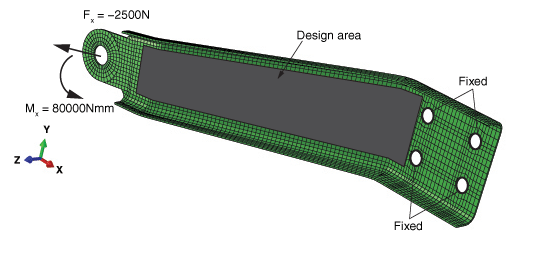Application description
This example illustrates sizing optimization of a pressed sheet metal holder that is used in an automotive gearbox linkage. Sizing optimization modifies the thickness of the shell elements in the design area to achieve the optimized solution. The example illustrates freeoptimization of the shell thickness, with no regard for the thickness of adjacent elements, and clustered optimization of the shell thickness, that forces elements in selected regions to have the same shell thickness. For more information, see Sizing Optimization.
Geometry
The pressed sheet metal holder is a single orphan mesh part. The part is meshed with general-purpose conventional shell (predominately S4) elements. The initial shell thickness is 1.0 mm.
Materials
The holder is made of an elastic material with a Young's modulus of 206 GPa, a Poisson’s ratio of 0.3, and a density of 7840 kg/m3.
Boundary conditions and loading
The boundary conditions and loads are shown in Figure 1. The four mounting holes are constrained in all directions in the initial step. During the first linear perturbation step a −2500 N load is applied to the hole in the x-direction. During the second linear perturbation step a torsional moment of 80,000 Nmm about the x-axis is applied to the hole.
Optimization features
The sizing optimization is configured as described in the following sections.
Optimization task
This example creates a sizing optimization task.
Design area
The design area of the model is the region that will be modified during the optimization, as shown in Figure 1.
Design responses
A design response is created for each step that determines the compliance or strain energy in the design area. A second design response calculates the volume of the entire model.
Objective function
The objective function tries to minimize the maximum compliance from the two linear perturbation steps. Compliance is the reciprocal of stiffness, and minimizing the compliance is equivalent to maximizing the global stiffness.
Constraint
The shell thickness is constrained between absolute values of 0.1 and 3.0. In addition, the volume is constrained such that the total volume of the holder is less than or equal to the original volume.
Geometry restrictions
The example introduces clustered rings of shell elements of the same thickness in the design area. In effect, clusters generate strengthening ribs or rings in the sheet metal structure you are optimizing; clustered regions can be reproduced in manufacturing by layering sheets of constant thickness.





